The National Register of Historic Places (NRHP) is the United States federal government's official list of districts, sites, buildings, structures and objects deemed worthy of preservation for their historical significance. A property listed in the National Register, or located within a National Register Historic District, may qualify for tax incentives derived from the total value of expenses incurred in preserving the property.
The History of the National Register of Historic Places began in 1966 when the United States government passed the National Historic Preservation Act (NHPA), which created the National Register of Historic Places (NRHP). Upon its inception, the U.S. National Park Service (NPS) became the lead agency for the Register. The Register has continued to grow through two reorganizations, one in the 1970s and one in 1980s and in 1978 the NRHP was completely transferred away from the National Park Service, it was again transmitted to the NPS in 1981.
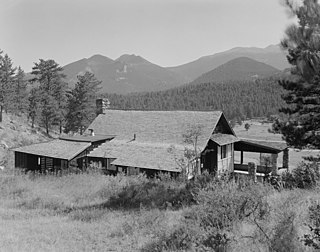
The William Allen White Cabins are chiefly associated with newspaper editor William Allen White, who adopted what would become Rocky Mountain National Park as his summer residence from 1912 to his death in 1944. White had visited Estes Park, Colorado while in college, and had previously summered in Colorado Springs. In 1912, White and his wife Sallie purchased an 1887 cabin near Estes Park. The Whites expanded it the next year and built a privy, studio, and two guest cabins.

The Twaddle-Pedroli Ranch, also known as the Jackson-Harp Ranch, Rand Property and the Wilson Commons Ranch, was purchased by John Twaddle in 1869 for $5,000. The ranch, several miles to the north of Franktown, Nevada and adjacent to the Bowers Mansion, was then known as the Sturtevant Ranch. The property amounted to 630 acres (250 ha).

The Edisen Fishery is a fishery located in Rock Harbor in the Isle Royale National Park in Michigan. It was designated a Michigan State Historic Site in 1976 and listed on the National Register of Historic Places in 1977.
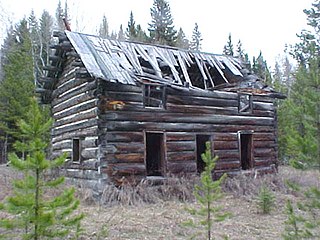
The J.K. Miller Homestead in Glacier National Park near Big Prairie, Montana, United States, was built in 1909. It was listed on the National Register of Historic Places in 1988. The listing included three contributing buildings and one other contributing structure.

Robert Parkinson Farm is a historic property in Morris Township, Pennsylvania. The contributing buildings are the c. 1830 house, c. 1830 banked barn, c. 1870 sheep barn, c. 1880 hay shed, c. 1880 spring house, and a c. 1920 privy. The house is a five-bay center passage farmhouse with an attached rear kitchen in a T-shaped floor plan. The Parkinson Farm is an example of an early 19th-century sheep farm, and it continued to operate as such until about 1960.

The Big Run Baptist Church and Cemetery, also known as Franklin Township Historical Society, is a historic Baptist church and cemetery located at 6510 South Franklin Road in Franklin Township, Marion County, Indiana. The church was built in 1871 as a Baptist meeting house and served the church congregation until 1977. It is a one-story, gable front brick building with Italianate style design elements. The associated cemetery was established in 1854, with one stone dated to 1841. The most recent burial was in 1986. Also on the property is a contributing privy constructed about 1920. The Franklin Township Historical Society acquired the property and now uses the building as a historical museum.

The Old School Privy is a historic outhouse in the village of Genoa, Ohio, United States. Constructed in the 1870s, it has the unusual distinction of being both a public toilet and an official historic site.

The Tucker Mountain Schoolhouse is a historic one-room schoolhouse on Tucker Mountain Road in Andover, New Hampshire. The small wood-frame building was built in 1837, and served as a schoolhouse until 1893, when it was closed due to declining enrollments. The building was listed on the National Register of Historic Places in 2005. It is now owned by the Andover Historical Society, and is occasionally open to the public in the summer.
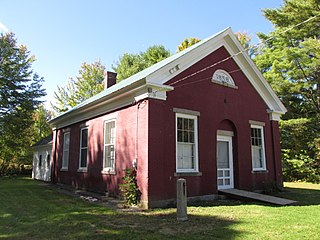
The District No. 2 Schoolhouse, also known as the Little Red Schoolhouse, is a historic one-room schoolhouse at 2851 Wakefield Road in Wakefield, New Hampshire. Built in 1858–59, it was at the time one of the finest district schoolhouses in rural New Hampshire. It was used as a school until 1941, and now houses the museum of the local historical society. The building was listed on the National Register of Historic Places in 1980.

Daniel Nelson House and Barn, also known as the Nelson Pioneer Farm and Museum, are historic buildings located north of Oskaloosa, Iowa, United States. Daniel and Margaret Nelson settled here in 1844, a year after this part of Iowa was opened to settlement by the U.S. Government. Their first home was a log structure, non-extant, located northeast of the present house. The present house is a two-story, brick structure with a gable roof. The wooden porches on the front and back of the house date from 1898 to 1900. The large barn measures 61 by 46 feet, and was built in 1856. It is composed of board and batten construction from oak that was milled on the site. It was used largely as a granary, rather than a shelter for farm animals. Three other buildings included in the historic designation include the summer kitchen, woodshed, and a small outdoor privy. The dates of construction for the three frame buildings is unknown. The farm remained in the Nelson family until 1941 when it was abandoned with most of the original furnishings intact. The property was donated to the Mahaska County Historical Society, which now operates it as a museum. Other historic buildings have been moved to this location over the years. It was listed on the National Register of Historic Places in 1974.

Highlandville School, also known as Highlandville Village School, is a historic structure located in the unincorporated community of Highlandville, Iowa, United States. It was built in 1911, replacing a 1904 building that was destroyed in a fire. The frame building follows a broad T-plan. The top of the T is a two-room rectangular section capped with a hip roof. A single-room, central projecting gable-front with a belfry forms the T's upright. The front section was used an entryway/coatroom, while the two-room back section housed the classrooms. The frame structure rests on a limestone basement. An entrance ramp replaces the original entrance steps. Two privies, which share the historic designation, are located to the north of the main building. The school was operated independently until 1960, and it closed in 1964. It stands as a reminder of the state of Iowa's determination to educate its citizens, particularly in the rural areas. It is also a unique rural two-room schoolhouse in Winneshiek County. The building was listed on the National Register of Historic Places in 2014.

The C.D. and Eliza Heath Bevington Privy is a historic building located in Winterset, Iowa, United States. Bevington was a pharmacist who passed through the area in 1849 on his way to the California Gold Rush. He settled in Winterset in 1853 after he made his fortune, and worked as a real estate agent, farmer, livestock dealer, and banker. The 7.5-by-10.33-foot structure is composed of roughly squared quarry faced rubble that is laid in a two against one bond. There is a stone vault with a depth of 6 feet (1.8 m) beneath the entire structure. The privy served the C.D. Bevington House. It was listed on the National Register of Historic Places in 1987. It is now part of a museum complex operated by the Madison County Historical Society.
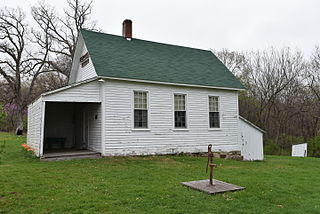
East Amsterdam School is a historic building located southwest of Pella, Iowa, United States. The Wabash Railroad began construction of its line through this area in 1882. The route split the Independent School District of Amsterdam in two, and it required that its only school building be torn down. They decided to build two school buildings, East Amsterdam School and West Amsterdam School, so the districts children would not have to cross the tracks. The west building is no longer extant. The East Amsterdam School was in use from 1882 to 1960 when it was closed by the Pella Community School District, with which it had merged in 1958. It is now a museum operated by the Pella Historical Society. The building was listed on the National Register of Historic Places in 2000.

The Spencer Hollow School is a historic school building at 50 Spencer Hollow Road in Springfield, Vermont. Built about 1810, it is a fine local example of a district schoolhouse. It was used as a school until 1926, and as a clubhouse for a time thereafter. It was listed on the National Register of Historic Places in 2012.

Logan Center School No.5 is a historic one-room schoolhouse located south of Dickens, Iowa, United States. The property was bought for a school in 1894 for $20, and the building was constructed the following year. Enrollment here averaged between 25 and 30 students until the 1930s when it started to decline. The school was closed in 1941 when it was incorporated into the Gillett Grove Consolidated School. The building is located in the center of Logan Township. Because the township has no incorporated communities the school building has functions as a township hall, a polling place, and hosts other community events. The building was also used for worship services and religious instruction. The original privy remains in the back, but a woodshed that was part of the historical nomination has subsequently been removed. The schoolhouse and privy were listed together on the National Register of Historic Places in 2001.
Fred Maytag Park is a public park located in Newton, Iowa, United States. It was listed as a historic district on the National Register of Historic Places in 2010. At the time of its nomination it contained 39 resources, which included seven contributing buildings, nine contributing sites, eight contributing structures, four contributing objects, four non-contributing buildings, two non-contributing sites, three non-contributing structures, and two non-contributing objects. The park was a gift from F.L. Maytag, founder of the Maytag Company, to the people of Newton. It is significant as an example of a privately funded public park during the Great Depression. The 40-acre (16 ha) partial of land was acquired by Maytag in 1935. It had previously served as the fairgrounds owned by the Jasper County Agricultural Society. He made an agreement with the city council that the park would be privately owned and operated, but open for public use. The city was required to provide water and electricity. It remained a privately owned park until 1977 when it was conveyed to the city.
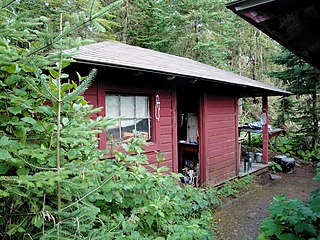
The Tobin Harbor Historic District is a small resort community, consisting of 12 private camps and a fishery, scattered among several islands at the northeast end of Isle Royale near Rock Harbor. It was listed on the National Register of Historic Places in 2019.

The Chandler Bookstore is a historic building in Chandler, Oklahoma. It was designed in the Late Victorian architectural style, and built in 1903 by A. E. Mascho as a dry goods store. It later became a bookstore run by Mascho's descendant, Bill. It has been listed on the National Register of Historic Places since April 5, 1984.


















